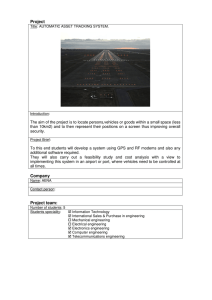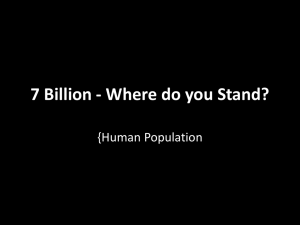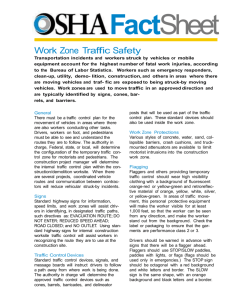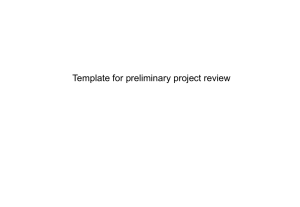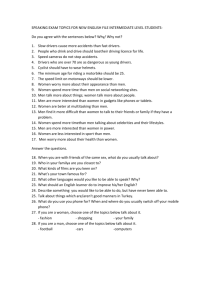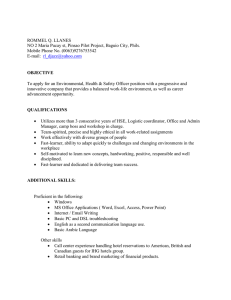Document 13135819
advertisement
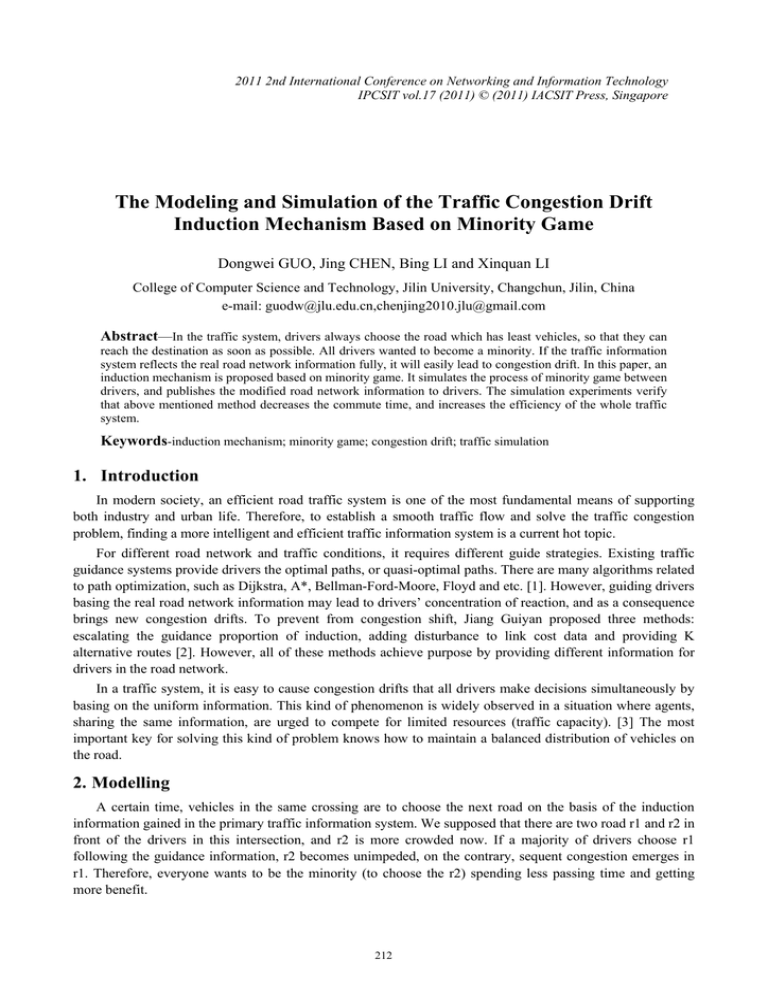
2011 2nd International Conference on Networking and Information Technology IPCSIT vol.17 (2011) © (2011) IACSIT Press, Singapore The Modeling and Simulation of the Traffic Congestion Drift Induction Mechanism Based on Minority Game Dongwei GUO, Jing CHEN, Bing LI and Xinquan LI College of Computer Science and Technology, Jilin University, Changchun, Jilin, China e-mail: guodw@jlu.edu.cn,chenjing2010.jlu@gmail.com Abstract—In the traffic system, drivers always choose the road which has least vehicles, so that they can reach the destination as soon as possible. All drivers wanted to become a minority. If the traffic information system reflects the real road network information fully, it will easily lead to congestion drift. In this paper, an induction mechanism is proposed based on minority game. It simulates the process of minority game between drivers, and publishes the modified road network information to drivers. The simulation experiments verify that above mentioned method decreases the commute time, and increases the efficiency of the whole traffic system. Keywords-induction mechanism; minority game; congestion drift; traffic simulation 1. Introduction In modern society, an efficient road traffic system is one of the most fundamental means of supporting both industry and urban life. Therefore, to establish a smooth traffic flow and solve the traffic congestion problem, finding a more intelligent and efficient traffic information system is a current hot topic. For different road network and traffic conditions, it requires different guide strategies. Existing traffic guidance systems provide drivers the optimal paths, or quasi-optimal paths. There are many algorithms related to path optimization, such as Dijkstra, A*, Bellman-Ford-Moore, Floyd and etc. [1]. However, guiding drivers basing the real road network information may lead to drivers’ concentration of reaction, and as a consequence brings new congestion drifts. To prevent from congestion shift, Jiang Guiyan proposed three methods: escalating the guidance proportion of induction, adding disturbance to link cost data and providing K alternative routes [2]. However, all of these methods achieve purpose by providing different information for drivers in the road network. In a traffic system, it is easy to cause congestion drifts that all drivers make decisions simultaneously by basing on the uniform information. This kind of phenomenon is widely observed in a situation where agents, sharing the same information, are urged to compete for limited resources (traffic capacity). [3] The most important key for solving this kind of problem knows how to maintain a balanced distribution of vehicles on the road. 2. Modelling A certain time, vehicles in the same crossing are to choose the next road on the basis of the induction information gained in the primary traffic information system. We supposed that there are two road r1 and r2 in front of the drivers in this intersection, and r2 is more crowded now. If a majority of drivers choose r1 following the guidance information, r2 becomes unimpeded, on the contrary, sequent congestion emerges in r1. Therefore, everyone wants to be the minority (to choose the r2) spending less passing time and getting more benefit. 212 In the sphere of applied mathematics, this is called the common limited resource distribution problem, of which known derivations are the “El farol bar problem” proposed by economist W.B.Arthur [4]. Then D.Challet and Y.C.Zhang proposed it in the form of game theory. It is called minority game [5]. Actually, path choice problem is a process of minority game. If the number N of choosing r1 is within a certain threshold m, r1 is free-flowing and everyone in r1 can gain much. But N is over threshold m in case, the efficiency of the traffic system will decrease rapidly. The gains of drivers in r1 will reduce by a wide margin, contrarily, the minority choosing the other road r2 will obtain more benefits. 2.1 Path choice method based on Underwood model There are many models to study the relationship between traffic density and speed, for example: the Greenshield model, the Greenberg model, the Underwood model, the Drew model, the Drake model, etc.[6] In this paper the Underwood model is used which is proposed by Underwood based on traffic studies on the Merritt Parkway in Connecticut. It is a macroscopic, single-regime exponential. (Underwood, 1961) V = Vf × e − N Nm (1) In formula (1), N and N m are the density and optimum density at maximum flow, V and V f are the speed and free-flow speed. [7] Thus we get the transit time t as follows: t = L × e b× N (2) Here, L is the simulated length of the path. Particularly when N = 0, t =L, users go through the path used the minimum transit time. In fact they are in the ideal speed. b is the saturation capacity parameter of Path, b = 1 / N m . [8] When b × N is very large, we can consider the path is near to its saturation capacity. In this paper, we only consider those drivers excluding public transport drivers, and analyze how to choose one of two paths from single origin to single destination. Simplified traffic path network model shown in Figure 1. Drivers who want to reach point D from point A must make a choice in two paths (path1 and path2) from point B to point C. Figure 1 . Simplified traffic path network model When drivers arrive the point B, they get the transit time of path1 and path2 from the traffic information system.We suppose all drivers are rational. They believe the published information, and will choose the best path by their analysis. We suppose the traffic condition is that path1 is more crowded than path2. Because the induction information is approximate the real traffic situation, the transit time of path1 is more than path2 by calculating. Then wise drivers will choose path2, so more and more vehicles swarm into path2. It is can be seen from minority game, when the number of users choosing the same source is larger than the threshold, transit time will increase rapidly. In the contrast, path1 will become unimpeded for minority’s choice. But there are some space between the number of vehicles and the threshold, so it caused wasting of resources. Therefore, majority earns little profits, and the efficiency of whole traffic system descends. Consequently, we need to amend the induction mechanism, so that the vehicles distribute more balanced in different road, and the capacity resources will be took advantage full to reduce the congestion drifts. 2.2 Induction mechanism 213 The system publishes the transit time calculated by modified method of calculation. Before travelling, the driver chooses the best road according to the information. The information is published to all drivers in the road network, so it maintains the unbiased and consistent. Saturation capacity parameters are modified as, b' = b×β 1 + exp( α b − N) (3) The parameter N is the total number of drivers in the road. And α is crowded parameter, β is predefined parameter. b ' is the modified value of b in formula (2). The function is the transformation of the sigmoid function. When there are a small quantity of vehicles, the difference between b ' and b is relatively small. When the number of vehicles reaches threshold associated with the crowded parameter α once, b ' will increase largely compared with b, so that it will affect the travel time. 3. Simulation Experiments and Results Analysis 3.1 Simulation algorithm 1. Initialize the road network graph with n crossings. 2. Generate vehicles randomly according to a certain ratio p, the starting and ending point of every vehicle distribute in different city. 3. The traffic information system calculates the new transit time information. For every road ij, use the formula (2) and formula (3) to calculate timeij which is the transit time from linked crossing i to j. α = 2.0, β = 1.6 . It is important that this data is modified. 4. Publish all the transit time of all roads to drivers in the road network. 5. According the information, every driver chooses the next road spending the shortest time. If the vehicle arrives at the destination, statistics the total travel time. 6. If (step<NUM), go to 2; else print the statistical data. NUM is predefined total value of operating steps. 3.2 Road network model In this simulation experiment, we choose the two bridges road network model. It is composed by 26 two-way roads and 18 crossings. Every road has two important performance parameters mainly -- length parameter and saturation capacity parameter. The model as showed in figure2. Let's pay close attention to bridge1 and bridge2 in the road network. Both bridge1 and bridge2 has the same length, 200. But the capacity of bridge1 is twice of bridge2. The vehicles generated randomly will travel from one city to another. This means that every vehicle must pass over the two bridges. We analyze the effectiveness of the induction strategy by the changed data -- the amount of vehicles on the bridges. 3.3 Simulation results analysis Based on calculating transit time by using the real saturation capacity parameter before modified, the traffic information system induces the vehicles in the road network. In which, the generation ratio p=6.85. We get the data from 1500th step to 3000th step, as showed in figure 3. In the figure 3, the blue line and the pink line stand for the changed tendency varying with time of vehicles’ count on the bridge1 and bridge2 separately. We can see the two curves appear cyclic variation, and the difference of their phase position is half of cycle exactly. It means that while the number of vehicles on bridge1 becomes the peak value, most of vehicles choose the bridge2 following the induction information. As a result, the number of vehicle on bridge1 reduces to valley value, and the jams are eased. On the contrary, the large amount of vehicles on bridge2 caused a new congestion. The situation emerges repeatedly. In other words, the real induction information causes congestion drift. After using modified parameter in the traffic information system, we get the data as shown in figure4. In the figure 4, we can see both of the two curves fluctuate slightly, and the periodicity weaken too. That is to say the change of the number of vehicles on bridges is smooth and steady, and the distribution of vehicles 214 is more balanced. It means that the traffic condition of two bridges is steady, and congestion drift is disappeared. TABLE I. AMPLITUDE VARIANCE AND TRANSMIT TIME Amplitude variance of bridge1 Amplitude variance of bridge2 Average transmit time Arrival vehicles rate unmodified 39.68 24.95 5.01 0.529 modified 18.24 17.58 4.87 0.524 As table 1 show, in the modified induction strategy, the amplitude variances of both bridge1 and bridge2 are decreased drastically, by 54% and 29.5%. At the same time, the average transmit time is decreased by 3%, and arrival vehicles rate are almost equal. That is to say the strategy takes advantage of the limited capacity well, and prevents congestion drift. It not only spends less time to arrive the destination for drivers, but also improves the efficiency of the whole traffic system so that the roads become more unimpeded. To study the two kinds of induction information influence on different number of vehicles, we conduct experiments on different vehicles generation rate. The results are shown table 2. The comparison data indicate that the average transmit time and the amplitude variance of bridges are getting smaller and smaller with the vehicles generation rate rising. The phenomenon verifies K. Wundcrlich's study result. After the congestion occurred, drivers guided by induction can save 3%-9% travel time compared with the unguided after congestion and the stronger the degree of traffic congestion, the greater benefits induced drivers obtain. [9] 7. Conclusion We proposed a traffic induction mechanism based on minority game. It is shown that the guide information reflecting the real traffic condition will lead up to the congestion drift. It is verified that the induction strategy proposed in paper avoids the wasting of limited resources caused by uneven distribution of resources. While preventing the congestion drift, the induction mechanism improves the efficiency of whole traffic system, and reduces the average traffic time meanwhile. Moreover, the induction mechanism proposed in the paper can be applied to network information traffic and others. TABLE II. Vehicles generation rate 6 7 8 9 10 11 12 13 14 15 16 SIMULATION RESULT ON DIFFERENT VEHICLES GENERATION RATE Unmodified Modified modified/unmodified Variance of bridge1 Variance of bridge2 2.14 56.1% 68.5% 112.8% 19.83 5.11 72.1% 46.4% 98.2% 15.39 20.18 5.47 97.8% 130.9% 97.2% 5.78 16.82 19.52 5.62 117.5% 105.3% 97.2% 22.62 5.84 15.85 19.59 5.72 84.6% 86.6% 97.9% 35.47 38.05 5.89 18.38 20.09 5.80 51.8% 52.8% 98.5% 85.24 87.20 5.97 22.33 21.70 5.88 26.2% 24.9% 98.5% 146.38 149.98 6.10 22.82 22.43 5.95 15.6% 15.0% 97.5% 203.08 206.34 6.31 24.10 23.77 6.04 11.9% 11.5% 95.7% 224.21 228.74 6.46 38.32 34.58 6.15 17.1% 15.1% 95.2% 236.62 248.65 6.60 78.82 78.96 6.32 33.3% 31.8% 95.9% Variance of bridge1 Variance of bridge2 Average transmit time Variance of bridge1 Variance of bridge2 24.93 15.69 1.90 17.08 8.80 39.39 27.51 5.21 18.27 15.73 15.41 5.63 14.31 18.53 18.72 Average transmit time Average transmit time 8. References [1] Zheng zu-tuo. “Research on key technologies of the dynamic route optimization”[D]. Jilin University, 2006. 215 [2] Jiang Gui-yan, Zheng Zu-tuo, Bai Zu, Zhao Jia-qi, Dai Lei-lei. “Causes and preventive technologies of traffic congestion shift“. Journal of Traffic and Transportation Engineering, 2007, 7(4). [3] Sagara , H and Tanimoto, J, “A study on social diffusive impacts of a novel car-navigation-system sharing individual information in Urban traffic systems,” Evolutionary Computation, pp. 836-842,2007. [4] D. Challet and Y. C. Zhang, ”Emergence of Cooperation and Organization in an Evolutionary Game,” Physica A, col. 246,pp. 407-418,1997. [5] W.B.Authur, “Inductive reasoning and bounded rationality,” in Proc. American Economic Association Papers, vol. 84,no.2,pp. 406-411,1994. [6] C. Quek, M. Pasquier *, B. Lim, ”A novel self-organizing fuzzy rule-based system for modelling traffic flow behavior”, in Expert Systems with Applications 36 (2009) 12167–12178. [7] Underwood, R. T. (1961). Speed, volume and density relationships, quality and theory of traffic flow, Bureau of Highway Traffic, Yale University, New Haven, Conn. (pp.141–188). [8] Dongwei Guo and Xinquan Li, “Model of Traffic Path Choice based on Game Theory and Induction Mechanism,” 2010 Ninth International Symposium on Distributed Computing and Applications to Business, Engineering and Science, pp.495-498 , 2010. [9] K. Wunderlich. “A Simulation-Based Assessment of Route Guidance Benefits under Variable Network Congestion Conditions” [J]. Mathl.Comput.Modelling, 1998, 27(9-11):87-101. Figure 2 . The two bridges model Figure 3 . The traffic data before modified. Figure 4 . The traffic data after modified 216

